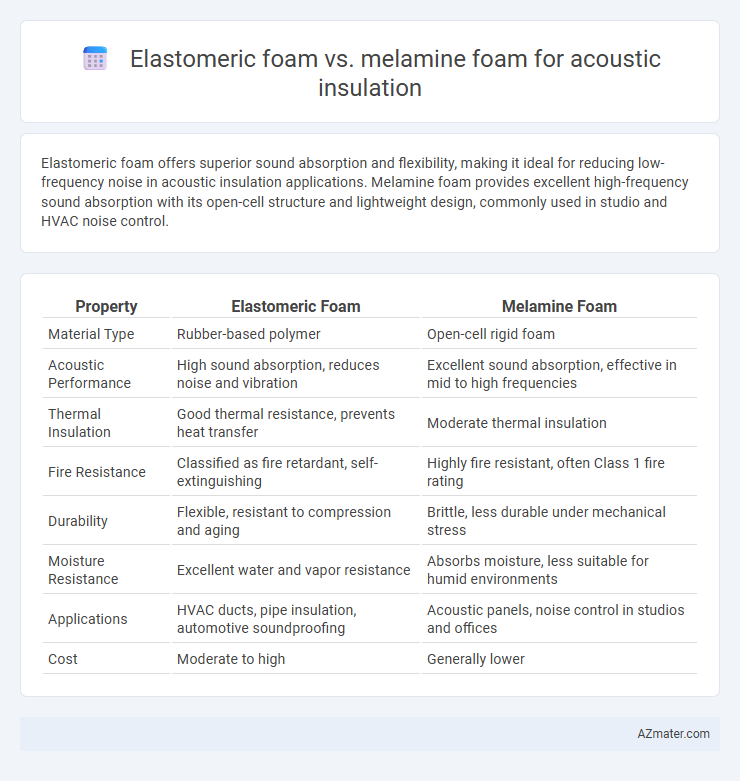Elastomeric foam offers superior sound absorption and flexibility, making it ideal for reducing low-frequency noise in acoustic insulation applications. Melamine foam provides excellent high-frequency sound absorption with its open-cell structure and lightweight design, commonly used in studio and HVAC noise control.
Table of Comparison
| Property | Elastomeric Foam | Melamine Foam |
|---|---|---|
| Material Type | Rubber-based polymer | Open-cell rigid foam |
| Acoustic Performance | High sound absorption, reduces noise and vibration | Excellent sound absorption, effective in mid to high frequencies |
| Thermal Insulation | Good thermal resistance, prevents heat transfer | Moderate thermal insulation |
| Fire Resistance | Classified as fire retardant, self-extinguishing | Highly fire resistant, often Class 1 fire rating |
| Durability | Flexible, resistant to compression and aging | Brittle, less durable under mechanical stress |
| Moisture Resistance | Excellent water and vapor resistance | Absorbs moisture, less suitable for humid environments |
| Applications | HVAC ducts, pipe insulation, automotive soundproofing | Acoustic panels, noise control in studios and offices |
| Cost | Moderate to high | Generally lower |
Introduction to Acoustic Insulation Materials
Elastomeric foam offers excellent sound absorption due to its closed-cell structure, providing superior thermal insulation and resistance to moisture, making it ideal for HVAC systems and industrial applications. Melamine foam, characterized by its open-cell, lightweight structure, excels at high-frequency sound absorption and fire resistance, commonly used in architectural acoustics and noise control panels. Both materials enhance acoustic insulation performance but differ significantly in density, application environments, and soundproofing capabilities.
Overview of Elastomeric Foam
Elastomeric foam is a flexible, closed-cell material widely used for acoustic insulation due to its superior sound absorption and thermal insulation properties. Its dense structure effectively reduces noise transmission and vibration, making it ideal for HVAC systems, building walls, and automotive applications. Compared to melamine foam, elastomeric foam offers enhanced durability and moisture resistance, ensuring long-lasting acoustic performance in various environments.
Overview of Melamine Foam
Melamine foam is a lightweight, open-cell material prized for its excellent sound absorption and thermal insulation properties, making it highly effective in acoustic insulation applications. Its unique microporous structure enables it to absorb a broad range of sound frequencies, particularly mid to high frequencies, reducing noise and echo in environments such as studios, offices, and industrial settings. Compared to elastomeric foam, melamine foam offers superior fire resistance and chemical stability, contributing to its widespread use in both commercial and residential acoustic treatments.
Acoustic Performance Comparison
Elastomeric foam exhibits superior sound absorption capabilities, particularly in low to mid-frequency ranges, due to its dense and flexible cellular structure that effectively reduces airborne noise and vibration. Melamine foam performs well in mid to high-frequency sound attenuation, leveraging its open-cell, lightweight composition to scatter and dissipate sound waves efficiently. When comparing acoustic insulation, elastomeric foam offers enhanced noise reduction for industrial applications, while melamine foam excels in environments requiring high-frequency sound control, such as recording studios and conference rooms.
Thermal Properties and Insulation
Elastomeric foam offers superior thermal insulation due to its closed-cell structure, resulting in lower thermal conductivity values around 0.035 W/m*K, which effectively reduces heat transfer in acoustic applications. Melamine foam's open-cell composition provides excellent sound absorption but less thermal resistance, with typical thermal conductivity ranging from 0.038 to 0.045 W/m*K. Selection between elastomeric and melamine foam depends on prioritizing either enhanced thermal insulation or superior sound absorption in acoustic insulation projects.
Fire Resistance and Safety Standards
Elastomeric foam provides superior fire resistance, meeting ASTM E84 Class A standards with low smoke development and flame spread, making it ideal for safety-critical acoustic insulation applications. Melamine foam, while effective for sound absorption, generally exhibits lower fire resistance and higher smoke toxicity, often failing to comply with stringent fire safety codes. Choosing elastomeric foam ensures compliance with NFPA 285 and UL 94 standards, enhancing safety in building acoustics without compromising performance.
Durability and Longevity
Elastomeric foam exhibits superior durability and longevity compared to melamine foam due to its robust closed-cell structure, which resists moisture, mold, and physical wear, ensuring effective acoustic insulation over extended periods. Melamine foam, while lightweight and effective at sound absorption, tends to be more brittle and prone to degradation under harsh environmental conditions, reducing its lifespan in acoustic applications. Elastomeric foam's resilience in varying temperature and humidity settings makes it a preferred choice for long-term acoustic insulation projects.
Installation and Maintenance Requirements
Elastomeric foam offers easy installation with its flexible, self-adhesive sheets that conform to irregular surfaces without specialized tools, reducing labor costs and time. Melamine foam requires careful handling during installation due to its brittle nature and often needs mechanical fastening or adhesives, increasing installation complexity. Maintenance for elastomeric foam is minimal as it resists moisture, mold, and degradation, while melamine foam demands regular inspections to prevent crumbling and loss of acoustic performance over time.
Cost Analysis and Economic Considerations
Elastomeric foam and melamine foam differ significantly in cost, with elastomeric foam generally priced higher due to its enhanced durability and thermal resistance properties, making it a long-term investment for acoustic insulation projects. Melamine foam is more affordable upfront, often preferred for budget-constrained applications, but may require more frequent replacement due to lower durability, impacting the total cost of ownership. Economic considerations also include installation expenses, fire safety compliance, and maintenance, where elastomeric foam can offer savings over time despite its initial higher cost.
Application Suitability: Choosing the Right Foam
Elastomeric foam excels in applications requiring durability, moisture resistance, and thermal insulation, making it ideal for HVAC systems and industrial acoustic barriers. Melamine foam offers superior sound absorption and fire resistance, suited for recording studios, offices, and environments with strict fire codes. Selecting the right foam depends on balancing acoustic performance needs, fire safety standards, and environmental exposure conditions.

Infographic: Elastomeric foam vs Melamine foam for Acoustic insulation
 azmater.com
azmater.com